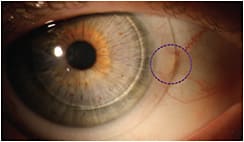Modern-day hybrid lenses can be empirically ordered by providing the manufacturing lab with keratometric measurements, horizontal visible iris diameter, and spectacle refraction. What other ocular features can impact the fit of a hybrid lens and when should fit modifications be applied?
CONJUNCTIVAL LUMPS AND BUMPS
A conventional soft contact lens will easily drape over most areas of elevation on the bulbar conjunctival surface such as pterygia, pingueculae, filtering blebs, or cysts, due to their nonrigid material and minimal edge thickness profile. There is limited literature on the known edge thickness of a silicone hydrogel (SiHy) hybrid contact lens skirt, however side-by-side handling of this lens in comparison to a conventional soft disposable contact lens reveals the hybrid soft skirt boasts a thicker edge profile.
Despite the increased thickness, the soft skirt of a hybrid contact lens will sit on top of focal conjunctival elevations without causing irritation to the wearer (Figure 1). The lens edge may start to fold or flute for larger elevations, however, the hybrid lens’ overall diameter is non-modifiable.

With continued lens wear, the SiHy skirt can begin to conform to the shape of the underlying elevation. This “breaking-in” effect of the soft skirt can be assessed during the one-week follow-up exam. During subsequent follow-up visits, it is important to remove a hybrid lens and stain the ocular surface to ensure that there is minimal epithelial staining over these areas to avoid inflamed tissue of the localized area with prolonged lens wear.
If nodules are found closer to the limbal border, rather than the outer limits of the SiHy soft skirt edge, bubbles may form in the soft skirt of the hybrid lens. These pockets can leave underlying areas of staining due to the stagnant trapped air. Applying a drop of preservative-free artificial tear into the bowl of the lens prior to application can help to remedy this finding.
LID ANATOMY
The centration of a hybrid lens on eye is key to successful lens wear for both visual quality and overall comfort. A taut upper or lower lid can excessively push the lens downward or upward, respectively, leading to patient complaints of discomfort with lens wear (Figure 2). Adjustments to the fit of the SiHy skirt to allow for a steeper fit can help the lens hug the conjunctival surface and improve centration of the lens on eye despite the lid posture.

WHAT ABOUT PUPIL SIZE?
The generous optic zone size of modern-day hybrid lenses (up to 8.5mm in the newest generation), means that larger-than-average pupil sizes can be fit without compromising visual quality. The one clinical consideration would be if the lens was decentered during scotopic lighting conditions resulting in glare, halos, or arc-like visual disturbances due to proximity of GP lens edge to the pupil edge. The best way to avoid this rare phenomenon is simple: center your hybrid lens fit! CLS




